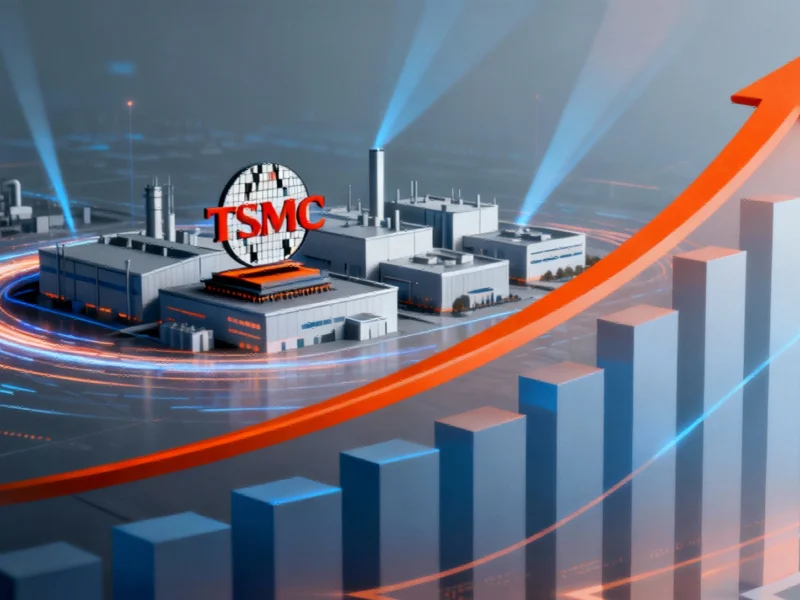Taiwan Semiconductor Manufacturing Company (TSMC), the world’s largest contract chipmaker, has announced remarkable financial results for the July-September quarter, with net profit surging nearly 40% year-over-year to reach an unprecedented 452.3 billion new Taiwan dollars ($15 billion). This performance significantly exceeded market expectations and underscores the transformative impact of artificial intelligence on global semiconductor markets.
The company’s record quarterly profit comes amid unprecedented demand for advanced processors powering AI applications across multiple industries. TSMC’s revenue growth of 30% year-on-year demonstrates the company’s dominant position in manufacturing cutting-edge chips for leading technology firms, including Apple and Nvidia. As AI continues to reshape workforce dynamics across sectors, the demand for computational power shows no signs of slowing.
Strategic Global Expansion Amid Geopolitical Tensions
TSMC has been actively diversifying its manufacturing footprint beyond Taiwan, with substantial investments in new fabrication plants in the United States and Japan. This strategic move aims to mitigate risks associated with ongoing China-U.S. trade tensions while ensuring stable supply chains for critical customers. The company has committed an additional $100 billion in U.S. investments, building upon previous pledges of $65 billion, including constructing advanced facilities in Arizona.
The chipmaker’s expansion strategy comes amid ongoing discussions about global semiconductor production distribution. Last month, U.S. Commerce Secretary Howard Lutnick proposed dividing computer chip production equally between Taiwan and the United States—a suggestion that Taiwan promptly rejected given its current position as the hub for the majority of global chip manufacturing.
Market Dominance and Analyst Confidence
Industry analysts remain bullish on TSMC’s prospects despite potential geopolitical challenges. Morningstar analysts recently noted that “demand for TSMC’s products is unyielding,” adding that the company’s market dominance would likely insulate it from potential tariffs on shipments to U.S. customers. The sustained resilience in AI demand positions TSMC favorably for continued growth throughout 2025 and beyond.
This optimistic outlook extends across the technology sector, where significant funding rounds continue to drive innovation and expansion. Similarly, strategic partnerships are becoming increasingly common, as evidenced by recent manufacturing collaborations announced across the industrial technology landscape.
Future Outlook and Industry Implications
TSMC’s extraordinary performance reflects broader trends in the semiconductor industry, where AI-driven applications are creating unprecedented demand for advanced processing capabilities. The company’s technological leadership in manufacturing the most sophisticated chips has positioned it as an indispensable partner for companies developing next-generation AI systems.
While TSMC continues to expand its global manufacturing presence, the industry watches closely as other major players make strategic adjustments. Recent reports indicate that even established manufacturers are reevaluating their product roadmaps, with Samsung reportedly canceling the Galaxy S26 Edge amid shifting market priorities.
The semiconductor giant’s record-breaking quarter demonstrates how AI transformation is driving fundamental changes across the technology ecosystem, from manufacturing strategies to global supply chain configurations. With AI demand showing no signs of abatement, TSMC’s continued innovation and expansion will likely remain critical to the global digital economy’s growth trajectory.
Based on reporting by {‘uri’: ‘manufacturing.net’, ‘dataType’: ‘news’, ‘title’: ‘Manufacturing.net’, ‘description’: ‘Manufacturing.net provides manufacturing professionals with industry news, videos, trends, and analysis as well as expert blogs and new product information.’, ‘location’: {‘type’: ‘place’, ‘geoNamesId’: ‘5261457’, ‘label’: {‘eng’: ‘Madison, Wisconsin’}, ‘population’: 233209, ‘lat’: 43.07305, ‘long’: -89.40123, ‘country’: {‘type’: ‘country’, ‘geoNamesId’: ‘6252001’, ‘label’: {‘eng’: ‘United States’}, ‘population’: 310232863, ‘lat’: 39.76, ‘long’: -98.5, ‘area’: 9629091, ‘continent’: ‘Noth America’}}, ‘locationValidated’: False, ‘ranking’: {‘importanceRank’: 482874, ‘alexaGlobalRank’: 270100, ‘alexaCountryRank’: 105425}}. This article aggregates information from publicly available sources. All trademarks and copyrights belong to their respective owners.



